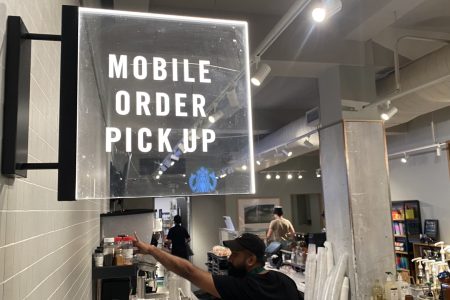Mobile order and Uber Eats and Doordash delivery pick up area at Starbucks coffee shop, Queens, New York.
Lindsey Nicholson | UCG | Universal Images Group | Getty Images
It’s become a familiar sight at Starbucks cafes: a counter crowded with mobile orders, frustrated customers waiting for the drinks they ordered and overwhelmed baristas trying to keep up with it all.
Fixing that problem will likely top incoming CEO Brian Niccol’s list of tasks to turn around the struggling coffee giant when he steps into the role on Sept. 9.
Investors and executives alike have pointed to operational issues as one reason the chain’s sales have lagged in recent quarters. Other culprits for its recent same-store sales declines include a weakening consumer, boycotts and the deterioration of the Starbucks brand.
Former CEO Howard Schultz, who lacks a formal role with the company but remains involved, has also pointed the finger at the mobile app. He said it has become “the biggest Achilles heel for Starbucks,” on an episode of the “Acquired” podcast in June.
Mobile orders account for roughly one-third of Starbucks’ total sales, and tend to be more complicated. While add-ons like cold foam or syrups are more profitable for Starbucks, they tend to take up more of baristas’ time, frustrating both them and customers.
“I agree with Howard Schultz,” said Robert Byrne, senior director of consumer research for Technomic, a restaurant market research firm. “This is not in the data — this is in the store. This is where the issue lies.”
Catching up to mobile growth
In late April, the current CEO Laxman Narasimhan said the company was struggling to meet demand in the morning — and scaring away some customers with long wait times.
Schultz said he experienced the problem himself when he visited a Chicago location at 8 a.m.
“Everyone shows up, and all of a sudden we got a mosh pit, and that’s not Starbucks,” Schultz said on the “Acquired” episode.
Making mobile orders more efficient is one of the key ways Niccol can reduce crowding at Starbucks.
When Schultz was building Starbucks to become the coffee behemoth it is today, he positioned it as a “third place” between work and home. Since then, the chain has lost that reputation as more customers lean on the convenience of mobile ordering and prefer not to linger at its cafes.
“Because it’s a beverage, and because I’m frequently consuming it in the car or on the go, it needs to be incredibly convenient,” Byrne said.
But Starbucks also didn’t make significant adjustments to its operations to anticipate that shift in consumer behavior.
In 2017, Schultz stepped down as CEO for the second time, handing the reins to Kevin Johnson. Prior to joining the coffee chain as its chief operating officer, Johnson served as chief executive of Juniper Networks, a tech company. Under his leadership, Starbucks invested in technology and kept growing digital sales, but restaurant operations were already struggling when he left the company.
Schultz stepped back…
Read More: Incoming Starbucks CEO Brian Niccol may target mobile app

